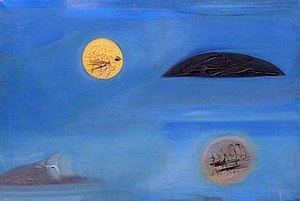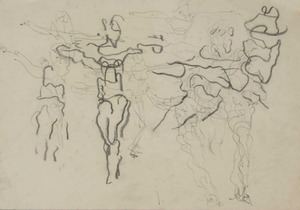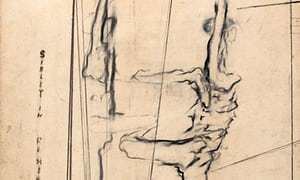Full Name Isabel Nicholas Education Royal Academy of Arts Role Artist | Name Isabel Nicholas Nationality British | |
 | ||
Born 10 July 1912 ( 1912-07-10 ) London, England, United Kingdom People also search for Alan Rawsthorne, Hubert Rawsthorne, Janet Bridge, Jessie Hinchliffe | ||
Isabel Rawsthorne, also known as Isabel Lambert, (1912 – 1992) was a British painter, designer and occasional artists' model. During the war she worked in Black Propaganda. She was intimate with many members of the artistic bohemian society in which she flourished, including Jacob Epstein, Alberto Giacometti and Francis Bacon, and was married three times; to the journalist Sefton Delmer, and to the composers Constant Lambert and Alan Rawsthorne.
Contents

Life

Born Isabel Nicholas, the daughter of a master mariner, in the East End of London, she was raised in Liverpool. She studied at the Liverpool College of Art, won a scholarship to the Royal Academy in London and spent two years in the studio of the sculptor Jacob Epstein.

Rawsthorne's first show was a sell-out and by September 1934 she was living in Paris. She worked with André Derain and lived and travelled for a time with Balthus and his wife. She was painted several times by Derain and Pablo Picasso. In 1936 she married her first husband, the foreign correspondent for the Daily Express, Sefton Delmer. The travel, parties and luxurious apartment in the Place Vendôme, never replaced her Left Bank life, however; and most days she made the long walk there and back. A lifelong Socialist, she visited Spain while Delmer was reporting the Spanish Civil War.
Rawsthorne was at the heart of the Paris avant-garde and became involved with Alberto Giacometti. They shared many intellectual enthusiasms and a commitment to a modern form of representational painting. Her characteristically astonished gaze and defiant stance can be seen in the new kind of etiolated figure that Giacometti developed over the next decade. The onset of World War II forced Rawsthorne to leave Paris. She relinquished at least one ticket out and did not flee until the day the Germans arrived on 14 June 1940.
She remained with Delmer for the first part of the war, but they eventually divorced. She maintained indirect links with France by working in intelligence and black propaganda for the Political Warfare Executive. During the Italian Campaign, she edited the magazine Il Mondo Libero. About this time, 1943–44, she encountered Francis Bacon within the arty set around the BBC, although they probably did not become intimate until a few years later. Rawsthorne's closest wartime friends appear to have been John Rayner (typographer, journalist and soldier (SOE), the photographer Joan Leigh Fermor (then Rayner), the Schiaparelli model, Anna Phillips, and the composer Elizabeth Lutyens, but her social life encompassed many others including the poets Louis MacNeice, Dylan Thomas (with whom she shared working quarters), Ian Fleming and old friends from Paris, Peter Rose-Pulham, Peter Watson (editor of the journal Horizon) and the spy Donald Maclean
Returning to Paris in 1945, Rawsthorne was re-united with Giacometti and lived with him for a short while, but they never married. She continued to be involved in the evolution of the figurative style associated with Existentialism. She socialised with Simone de Beauvoir, Jean-Paul Sartre, Jean Wahl, etc., and for a time lived a few doors away from the headquarters of the journal Les Temps Modernes. She also entertained the philosopher A J Ayer in Paris, and saw Eduardo Paolozzi and Bacon. There were relationships with Georges Bataille and the composer René Leibowitz, but in the winter of 1946/7 she withdrew to modest lodgings in the Indre to work alone. The composer Constant Lambert visited her in 1947 and they married later that year.
Following her second marriage, her base became London. Her art world associates, including Bacon and Lucian Freud, created a potent mix with a glitzier musical set, such as the Sitwells, Lutyens, Frederick Ashton, Margot Fonteyn, Alan Rawsthorne. From 1949, she and Bacon showcased their figurative brand of modern art at the Hanover Gallery and she exhibited in group shows organised by the ICA and the British Council. She began her career as a designer for the Royal Ballet and the opera at Covent Garden and Sadler's Wells.
Lambert died in 1951 and Rawsthorne returned to Paris to paint. She continued to see Giacometti, but eventually settled with Alan Rawsthorne. They moved to a thatched cottage in rural Essex with a purpose built studio, near friends such as the politician Tom Driberg, poet Randall Swingler, artists Michael Ayrton and Biddy and Roy Noakes; Bacon had a house not far away. Six of Bacon's portraits of Rawsthorne were shown in his 1967 show, including Portrait of Isabel Rawsthorne. In all, between 1964 and 1970 he painted 14 images of her, including five triptychs. Giacometti died in 1966 and Rawsthorne in 1971; Bacon outlived Rawsthorne by a few months. Apart from visits to London and Paris, Africa, Greece and Australia, and a short period in Cambridge (1972-3), she lived in the cottage for forty years - half of her life. She raised geese, a nod to her interest in Konrad Lorenz, and became involved in the emergent environmentalist movement. She and her last husband are buried in Thaxted churchyard.
Career
I am beginning to understand what pushes me into painting – the love of seeing and the fact as the chosen subject grows in beauty, so it becomes more elusive.'
Rawsthorne's work was dominated by the body, she painted figures and animals. Her father supplied exotic creatures to British zoos and as a child she took to drawing these and other wildlife. Later she became interested in natural history and new ideas in Anthropology, Ecology and Ethology, such as those of her friends Michel Leiris, Georges Bataille. These inform the skeletal bird, fish and bat figures of her 1949 Hanover Gallery show, the haunting ape series, and her last, large Migration pictures.
Rawsthorne's two years with Epstein and their mutual enthusiasm for Rodin developed her ideas about vitalism and movement, but she never became part of British Neo-Romanticism. In Paris she continuing her studies of the nude at the free and easy Académie de la Grande Chaumière. She associated with Giacometti, Tristan Tzara and the Surrealist circle but was committed to a figurative form of modern art. She called it ‘Quintessentialism’ She maintained connections to an alternative circle of representational artists: Francis Gruber and Peter Rose-Pulham, as well as Balthus and Derain. Her outlook was anti-idealist, intellectual and, like Giacometti, she saw painting from the real world as a challenge that could never be fully met.
During the 1940s Rawsthorne adapted animal, archaic and pre-historic imagery into motifs of birth, sexuality and death. She did not share the fashionable interest in the formal properties of Oceanic or Archaic art. Instead, she investigated the uncanny ‘presence’ achieved by ancient figures, especially Egyptian sculpture. She also studied this quality in Early Renaissance paintings, and in the evidence of the body itself, X-rays, skeletons, figures and animals she found in the countryside or drew in London Zoo.
In the 1950s and '60s her explorations of the embattled origins of art and life were adapted into designs for the ballet and opera, most scandalously a topless Minoan Tiresias created for the ballet of the same name premiered in 1951 at Covent Garden, the last work of her husband Constant Lambert. She continued her studies of the body, in motion this time, in the practice rooms of the Royal Ballet. Over the next twenty years she painted images of Fonteyn, Rudolph Nureyev, Antoinette Sibley and other dancers that developed a vivacious new language of movement. In 1961 she worked from the figure and landscape in Nigeria shortly after its Independence, at the Zaria Art School with the artist Clifford Frith (grandson of William Powell Frith).
Rawsthorne explored the ambiguities of appearance through the theme of the double – reflections, such as those seen in the practice room mirrors, for instance. During the late 1960s and 70s, the deaths of Giacometti and Rawsthorne prompted her to refine these ideas in a set of ethereal double portraits juxtaposing living, dead and sculpted likenesses. These works returned to the matière relief effects of the early 1950s and exchanged ideas with Bacon and the sculptor Roy Noakes[5]. Some of these new works and a selection of her innovative dancers were presented to the public at the Marlborough Gallery [6] in 1968.
From the 1950s onwards she developed a series of paintings based on the Essex countryside. Existential rather than pastoral, they responded to environmentalist publications such as Rachel Carson's Silent Spring. The last of these, Migrations, embed bird and animal motifs in timeless settings. The extraordinary brushwork and relief effects developed over a life-time of drawing in close association with sculptors, was combined with a new potency of colour and epic scale. Swathes of yellow evoke the deserts of pre-history and post-history, as well as the very immediate issue of the fields of oil seed rape that were appearing in the 1970s.
In later life, widely read biographies of Giacometti and Bacon brought Rawsthorne fame as a model and muse, but unfortunately had the effect of obscuring her main profession. By the 1980s she was better known as a once beautiful siren, or the bon viveur that Bacon partied with and painted as ‘Isabel Rawsthorne’. Since her death, however, serious scholarship has ensued and several paintings have entered public collections. A retrospective was held in 1997.
